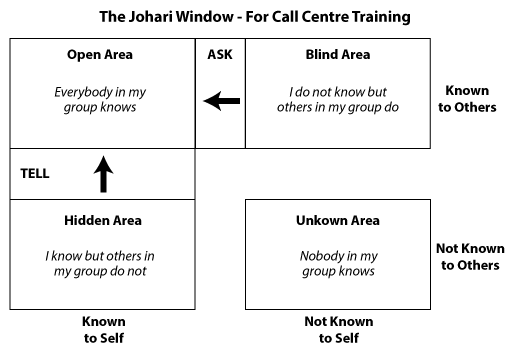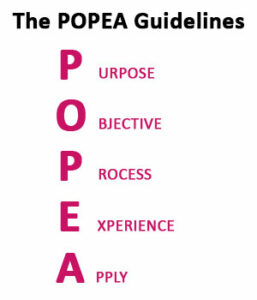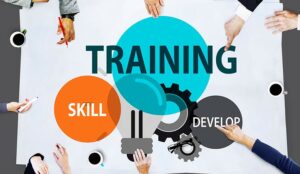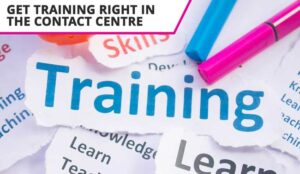We asked for call centre training tips and have been amazed by the response. There has never been a better time to train our call centre staff.
Call Centre Training Ideas
Here are the 50 great contact centre training tips we were sent.
1. Use Training Activities Like “The Johari Window”

One call centre training tool that can be used for continuous training is The Johari Window, an exercise that involves giving a group of 3-8 advisors a list of job-related questions and asking them individually categorise each question into the following grid.

These questions can include anything from: “Do you know our procedure for handling abusive customers?” To, “Are you confident in your knowledge of our X range of products?”
Once categorised, agents who have put questions in the “Hidden Area”, should TELL the other agents in the group, who did not know, the correct answer.
Alternatively, agents who have put questions in the “Blind Area”, should ASK the other agents in the group, who did know, for the correct answer.
If any questions are put into the “Unknown Area”, this is when the Team Leader should get involved and tell each advisor the correct answer.
Contributed by: Dave Salisbury
To find out more on the Johari Window and how to use it, read our article: The Johari Window: A Contact Centre Training Tool
2. Get the WFM Folks Into the Classroom
From a workforce management and operations perspective, it’s a great idea to get WFM (workforce management) folks into the classroom to sell employees on adherence and give practical tips on hitting KPIs.
To build enthusiasm and make top performance an achievable goal, bring top-performing employees into the room to share their energy, passion and secrets for being the best in the business. You can give your agents an Introduction to Contact Centre Analytics.
3. Follow the POPEA Guidelines

Be structured and let the delegates know what to expect, always engaging and ensuring everyone participates. A good way to do this is by following the POPEA structure highlighted below.
P – Purpose
What is the purpose of the session?
O – Objective
Have a SMART objective up on display and refer to it during and after the session.
P – Process
Outline what is going to happen throughout the session so there are no awkward surprises.
E – Experience
Understand the groups current experience, 1 – 10 and use the people with more experience to your advantage while focusing on the less experienced to ensure they fully understand.
Once the session is completed, review the experience, 1 – 10, and see if they feel the number has improved. If not, question why and ask for feedback with a follow up.
A – Apply
What are they going to do on the back of the session, how, and when? Ensure you have a lot of recap questions showing the session went well and everyone understood why they were there and what is expected of them going forward.
Contributed by: David Coletrie
4. Provide Real-World Advice
In short, don’t just train your employees by filling their heads with knowledge. Be sure to give them real-world advice and the encouragement they’ll need to succeed right out of the gate.
Sometimes trainers aren’t in a position to do this. That’s why it’s so important to bring experienced representatives into the room to have candid conversations about their own successes.
To build enthusiasm and make top performance an achievable goal, bring top-performing employees into the room to share their energy, passion and secrets for being the best in the business.
5. Include a Shadow Visit as Part of the Recruitment Process
A work shadow visit is part of our recruitment process for our call operatives. They are issued with a questionnaire at the start of their visit. This is used as part of the interview process.
Doing this provides 2 main benefits. Firstly, some trainees will come to conclusion that the job is not for them, thus lowering attrition rates, and secondly, it provides the introductory questions base at face to face interview. It gives a real insight into our world, the calls, and shift working.
Contributed by: Philly Hewlett
6. Lunch and Learn
Start lunchtime learning sessions where staff can elect to deliver a session on their topic of choice. Even if the topic isn’t work-specific, you’re giving staff the opportunity to see a different side of their colleagues, and the person delivering the session is able to share their energy and enthusiasm for something they’re passionate about. Great for upping the energy levels. Great for engaging staff.
Contributed by: Vandy Massey
7. Speed Training
Speed training is an innovative approach designed specifically for enhancing engagement among call centre staff. It incorporates interactive games and activities that focus on developing essential skills such as voice modulation and customer service techniques.
By making the training enjoyable and dynamic, employees can practice real-time scenarios, which improves retention and application of their skills. Ultimately, speed training not only fosters individual development but also strengthens team dynamics, creating a more motivated and effective workforce.
8. Create a Rookie Pod
A Rookie Pod is a dedicated training space within the contact center designed to ease new recruits into their roles. In this controlled environment, new advisors are given lower performance targets that gradually increase over a set period, such as twelve weeks.
This phased approach allows them to build their skills and confidence at a comfortable pace before joining the main contact centre team.
By providing structured support and manageable goals, the Rookie Pod helps reduce the pressure on new employees, improving retention and setting them up for long-term success.
For an example of a company implementing a Rookie Pod in real life, read our article: 17 Things You Can Learn from the AO Contact Centre
9. Create a Buddy System
Create a buddy system, which incorporates staff who behave well and portray values that you want future recruits to imitate.
So, let new staff watch what they do and get them to help new staff on their initial calls once a relationship exists between them.
Contributed by: Jason Weston
10. Let Agents Listen to Their Call Recordings
Allow your agents to listen to their own calls. When working on a coaching objective, you can also, after the initial coaching, get them to give you a call where they believe they have been able to implement that coaching.
Running through this process will result in the agent actively thinking about the coaching objective, which will help them to embed the training into every call.
Contributed by: Lesley Farley
11. Use Behavioural Types of Questions
For example “Tell me of a time when…” Ensure HR, Training, and Operations agree on the Orientation, Aptitudes, Attitudes and/or Values to be screened for. And then stick to them. So there needs to be a healthy balance between satisfying headcount and employing the right staff.
12. Avoid fluff in the curriculum
Ensure the curriculum has no fluff – that it teaches only need-to-know knowledge/skills.
13. Involve me, not tell me
Ensure the curriculum has very little lecture but is mostly practice. That is, the curriculum should be interactive and engaging.
Learners should NOT be idle – they should be doing.
14. A Performance-Based Test Should Be Used to Determine Graduation
This means metrics for a day-0 rep should be determined and incorporated in the performance-based test.
You should also create a seamless transition from classroom to floor. The above points should create no surprises for reps or Operations.
Hosting graduation ceremonies for agents helps start them off in a positive mood, and continuing this for those who have increased their skill set helps maintain a positive culture.
Contributed by: Kenneth Pack
15. Everything in a Call Centre Has to Be Done By the Simplest Method Possible
When a call centre rep is on the phone, nothing breaks concentration more than involved processes. Everything must be done with multi-tasking in mind if the rep is to be able to hit AHT/ACW/Sales goals or matrices.
Simple processes, simple procedures, simple, easy-to-implement computer aids, all mean that training time is reduced and productivity increases.
16. Work on Improving Knowledge Management
Our strategy for knowledge management is “Hone your skills to perfection and learn something new everyday”. This is because the only long-term competitive advantage for any organisation is the collective brainpower of its people.
Contributed by: Anurag Kull
17. Start Staff Learning Before They Arrive
A pre-induction learning portal is proving to be an excellent tool to dramatically improve engagement and productivity of new staff from their very first day.

Brightwave and Sky, the satellite television and media communications provider, worked together to build a pre-induction portal.
Up to ten hours of learning covering product knowledge, compliance topics, as well as sales simulations, have led to staff arriving confident and competent.
This has reduced induction training by one week and measurably improved sales and customer service performance.
The portal also won the Most Effective Training Programme award at the recent Customer Contact Association Global Excellence Awards. It’s a best practice model well worth replicating.
Contributed by: Lars Hyland
If your looking for ways to welcome new advisors on their first day, read this article: 8 Ideas to Welcome Your Advisors on Their First Day at Work
18. Teach Agents How to Create An Emotional Connection With Customers
Building upon the core psychology of communication “it is not what you say, it is how you say it”, the award-winning team at Lebara Limited have translated a vision to “make lives better” into a powerful operational culture. This reinforces an emotional connection with customers.
Training staff to create this emotional connection with the customer makes for memorable customer experience.
This emotional connection can also be achieved by using empathy statements that help to improve agent-customer rapport and by teaching agents to use positive words, whilst avoiding negative language, such as “no”.

19. Use a Quality Framework to Pinpoint Individual Training Needs
Being able to pinpoint the training needs for each individual member of your team can ensure that you are on course to having well-rounded agents in the call centre.
Many operations are already using call and email assessments to check the quality of interactions, and a quality framework will allow you to schedule and track agent development activities. This can be done through a variety of coaching, eLearning and group training methods.
Contributed by: Paul Weald, Contact Centre Innovator
Want to know steps to developing a successful call recording training strategy? Read our article: Recording Calls For Training Purposes
20. Use Free Online Tools

Popular video-sharing websites such as YouTube are a cost-effective and brilliant way to keep your call centre training sessions interactive, fun and engaging.
These websites offer a wide variety of free video footage – everything from humorous clips showing the top ten ‘call centre disasters’ to more serious footage demonstrating examples of high-quality customer service techniques.
These videos act as a great discussion starter for training sessions. Staff can be given time to find their own examples of good and bad practice and share their learning with the team.
Online video clips can also help to inspire other, more classic, training techniques such as role-play. Managers can show examples of poor customer service from YouTube and ask staff to role-play the way they think the call should have been dealt with.
Contributed by: Kevin Stillwell
21. Personalise the Training to Meet the Needs of the Trainee
Often training follows the ‘sheep dip’ approach where, regardless of knowledge levels or experience, everyone completes the same course.
By assessing current knowledge levels you can target training to each person’s ‘gap’. This ensures that the training is relevant to the trainee, and ensures that the trainees are more engaged.
For example, those that already have an excellent knowledge level might only need a refresh e-learning, those that have an average level of knowledge could receive a half-day workshop, leaving those new to the subject or lacking in knowledge taking the full 1-day workshop.
In addition, you are able to spend the training budget smarter by delivering training that has a bigger impact on the business.
Contributed by: Paul Wood
For advice on how to deliver more engaging and effective training, read our article: How to Deliver More Memorable and Effective Training
22. Take a Long Hard Look at Your Trainers
One tip I’ve picked up over the years is just a brutal fact of business. If your trainers came up through the organisation at a time when the company wasn’t performing up to standards, then take a long hard look at them.
Some trainers will often unwittingly encourage the same performance standards they “grew up with” in the company. Then you have a never-ending cycle of trying to break bad behaviours right out of the gate. This is especially true for training programmes that last for extensive periods of time.
If you’re looking for ways to train a trainer, read our article: Training the Trainer – Tips on Making it Work
23. Get Exceptional Agents to Deliver the Training
Finally, make sure you recruit agents with exceptional behaviour and performance to deliver on-the-job floor training.
Are they hitting adherence targets and any other KPIs? Or are they mediocre performers? These agents will directly influence your trainees in a big way. Something to think about!
Contributed by: Chris McCallister
24. Pilot Groups
A great place to start with developing a coaching culture is to have a small group of people who participate in a pilot of the scheme. This allows you to ‘iron out’ any changes before launching to the whole organisation.
Pilot groups provide valuable feedback on how systems are working in practice, and allow any changes to be made before a wider launch.
Pilot groups often become the biggest champions for successful projects and are of significant value when implementing wide organisational changes.
25. Coaching Does Not Need to be Formal

I think all managers find they need to listen, and the type of listening you do and how you respond can both be forms of coaching.
Communication is an integral part of being a manager and how you communicate can form a key part of coaching. Coaching doesn’t have to be a formal meeting at regular intervals.
Coaching conversations can take place anywhere, any time, for any length of time. In fact, sometimes the most effective coaching conversations can be the shortest. Take time to schedule informal conversations.
For advise on how to have a informal conversation with your agents, read our article: 10 Great Conversations to Have With Your Contact Centre Team
26. Partner With Other Similar Companies
In the areas of people skills and team working, it may be useful to partner with other similar-sized companies in the same area as you. Staff from each company could attend, with costs being shared proportionately.
27. Skill-Up Line Managers
Equipping line managers with the skills to deliver training to small groups of their staff can significantly enhance productivity. These training sessions provide opportunities for team members to collaborate more closely, strengthening trust and communication within the group.
Additionally, when managers take on the role of trainers, they reinforce their own expertise and leadership skills. This not only increases their effectiveness as leaders but also creates a more dynamic, hands-on learning environment for employees.
It can result in a ripple effect where the entire team becomes more knowledgeable and better equipped to tackle challenges.
For insights on how to improve your managers’ ability to lead training effectively, take a look at this article: Top Tips for Improving Team Managers’ Leadership Skills
28. Provide a Library
Provide a library of books and DVDs that people can use to increase their knowledge in their spare time. The company could make an initial investment and the collection could then be grown through setting up your own version of BookCrossings.
29. Focus on Staff Engagement as Well as Technical Ability
Ensure you have committed resources for training and development; training not only nurtures technical ability but also increases staff engagement, helping to motivate and retain talent.
When thinking about training, look closely at what skills are needed within your team. In a customer service call centre, training will often focus on product knowledge, complaint management or questioning techniques in first-call resolution.
In a sales-based call centre, training will also focus on ensuring employees are able to advise customers on the best-fit product or service.
Contributed by: Geoff Sims
30. Training is an Ongoing Process
Training should never be viewed as a one-time event. It is a continuous and evolving process, especially in today’s fast-paced business environment where market conditions, technology, and product offerings are constantly changing.
To remain competitive and ensure that employees are always performing at their best, companies need to invest in ongoing training that adapts to these shifts.
As new challenges arise and business strategies evolve, additional training becomes essential to equip employees with the knowledge and skills they need to succeed.
This is particularly important in sectors with rapid innovation or changing regulatory requirements, where staying current can have a direct impact on performance and compliance.
Refresher training is an effective way to reinforce and build upon existing knowledge while introducing new concepts. It allows employees to revisit important topics, refine their skills, and stay aligned with the latest business objectives.
31. Individual Training Tailored to Individuals
Whilst every agent in the contact centre will be using the same software and equipment, each one will have different skills and personality. Training should reflect this, developing their skills without over-emphasising any one particular area.
32. Training Doesn’t Always Have to Happen in the Classroom
Training needs to relate to the job at hand, so why move people away from the place they’ll be working in? If possible, incorporate relevant training into the working day, into the tasks and activities agents have to complete whilst dealing with customers.
Online training tools can also be incorporated, freeing people from the classroom and indeed the training centre and allowing training to take place on a genuinely ‘as needed’ basis.
Contributed by: Mark Smith
33. Online Training Simulations
It’s not so much a tip, but rather a form of training. We have created an online training simulation for a major US telecoms company, to train their staff in call handling, whether that be retention, troubleshooting or sales.
Effectively, agents can train at their desks in chunks of approx 15mins, making decisions based on their ‘virtual’ customers’ responses.
At the end of the ‘virtual’ call, agents receive feedback on their choices, comparing the route they took for the call to the ideal route.
All feedback can be printed out, allowing agents to refer to the documentation every time they have a similar real-life call.
Contributed by: Helen Axe
34. When Recruiting, Be Clear About Expectations
One thing I believe is very important before any training is that you have to be sure everybody understands why they are there.
You have to understand that the call centre environment is NOT for everybody before you provide training and then have recruits leave two months later when they realise it is not for them.
When recruiting, don’t just talk about how good it is work with you, but get the candidate to listen to a good call, an average call and a really bad call.
Talk about the bad days and what it is like to spend 6 or 8 hours on the phone, and when you are on your 120th call while it is your customer’s first contact with your company. After they understand this, you can train them in whatever you want.
Contributed by: Miguel Barcena
For more advice on successfully recruiting great call centre agents, read our article: How to Recruit the Right Call Centre Agent
35. Time is Money
Don’t minimise the initial training time to save money. Efficient use of time in training is essential. In other words, make every minute count. Eliminate exercises that don’t add value to the trainee, program, or client.
Utilise the time in training by integrating the new information with practice. Be flexible within the classroom. Employ different learning methods for different situations and utilise leadership. This often requires a prepared, experienced, connected trainer.
36. Accountability for Trainers to Ensure Long-Term Trainee Success
Trainers should be held accountable for the retention and performance of their trainees for at least six weeks after the training program concludes.
Tracking the progress of new-hire classes is essential not only for assessing the effectiveness of the training curriculum and content but also for emphasizing the value of the training experience.
When trainers are responsible for the outcomes of their trainees, it encourages them to deliver more impactful, engaging sessions that foster deeper understanding and retention.
Often, trainers focus solely on delivering material without considering how it translates into real-world performance.
However, accountability can motivate trainers to adopt a more holistic approach, where they actively think about the long-term implications of their teaching methods.
By implementing this accountability measure, organizations can enhance the overall quality of training and ultimately improve employee retention and performance outcomes.
37. Involving Trainers in the Transition from Training to Production
The transition from training to production is a critical phase that can significantly influence the success of newly trained employees.
Unfortunately, gaps often exist during this process, leading to a loss of momentum and even disengagement among staff.
Even if trainees have participated in “on-the-job” practice during their initial training, the shift to “real-time” application can feel overwhelming, creating a disconnect that can result in employees feeling lost or unsupported.
To address these challenges, many organizations are recognizing the importance of involving trainers in this transitional phase.
This joint effort not only reinforces the skills learned during training but also fosters a sense of continuity and confidence, enabling employees to thrive in their new positions.
38. Trainers Should be a Support to Operations
This may be done by periodically handling calls on the Operations floor, or it could be done by helping supervisors with operational tasks.
Monitoring quality would be an excellent way of support, and trainers must be involved in calibration sessions with Operations in order to make sure that quality is maintained.
I can not emphasise enough quite how important it is to include the training department as part of the Operations Team.
Trainers deliver a product that supports the production of the Operations team. Training is ongoing. The training process should be a tool that is used often and assists in the success of the entire centre.
For more information on how to get a better quality performance, read our article: How to Get Better Quality Performance from Feedback, Training and Coaching
39. Handling Calls During Induction Training
Handling calls during the initial training session is an activity that can not be eliminated from the curriculum. This is what new hires were hired to do.
Often either the equipment within the classroom doesn’t allow new hires to handle these calls or individual equipment is not available for handling calls on the production floor.
Maybe volume is so heavy on the call centre floor that the new hires are asked to eliminate a session of call taking due to seating shortages.
It is imperative that the new hires receive practice handling real-time calls. There is no substitute for this experience.
Role-play is good, but real call handling is essential. Trainers should make sure that equipment in the classroom works and is available for each “real-time” call handling session. Operations should make this a priority.
Contributed by: Patricia Carroll
40. Trainers’ and Subject-Matter Experts’ Tacit Knowledge Should Be Documented in the Curriculum
Trainers should collaborate with each other to ensure best practices of learning strategies and methods are also included in curriculum. Include Level 1 and Level 2 evaluations.
41. Learners Should Be Performing Their Job in the Classroom
Learners’ experience in the classroom should match their experience on the floor as closely as possible. Operations and HR should help to fill in gaps in the classroom – to set appropriate expectations of life on the floor.
42. Keep Sessions Short, Sharp and Avoid PowerPoint
Ensure any training sessions are short and sharp to keep agents focused, as holding their attention is just as important as the content itself.
Where content is detailed and will lead to a longer session, try to ensure regular breaks to avoid overwhelming your trainees.
It is also important to make sure the trainer is engaging and doesn’t hide behind a PowerPoint presentation, as these have the potential to kill a training session in its tracks.
Contributed by: Sue Coe
43. Ensure Hand-Off Between the Supervisor and Trainer
Before graduating from a ‘learning bay’ be sure there is a hand-off and agreement between the supervisor and trainer.
If there are issues – the trainer should keep the CSR for another week and then if it is still not working, kick ’em out the door.
Supervisors should see the stats and understand the good and bad of associates. Once the supervisor accepts responsibility, they are on the hook to some degree.
44. Identify the Core Competencies of the Position
Identify the core competencies that are most important for the role and where your target audience is within this framework. The more important the competence, the more important it is that you focus training time there.
If there are huge disparities between delegates, you can run courses at a different levels, but be careful not to label people as “good” or “poor” by doing so.
Contributed by: Chris Gallagher
45. Add Adaptable Training to the Weekly Training Session
Training in a call centre is at best generalised. Not every situation can be covered in training to ensure the rep is “fully capable to handle all situations”.
So, all training has to be generalised; but generalised training has the tendency to remove the ‘human element’, thus service levels suffer.
Adaptable training is conducted by supervisors on a one-on-one basis, with all the inputs for improving reps made by the rep after listening to their calls.
I am not advocating removing “generalised training” from the curriculum, but adding the adaptable training to the weekly training session of the new reps and to the monthly session with experienced reps.
Thus, through listening to the calls handled by the rep, individual strategic plans can be made, and personalised training can become adaptable to many different situations.
46. Use Periodic Training
Training should never be a once-in-a-lifetime thing. This is where adaptability comes into the workforce mix.
Weekly sessions to hear the calls, discuss plans, and drive for improvements should be an integral part of the overall call centre experience.
This has two benefits; it helps the reps see the need for constant upgrades to training while providing a forum to gain this training.
This time also gives team leads/supervisors the time and forum to personalise training to fix training holes from the generalised training the rep received.
If machinery needs periodic maintenance to keep in top running form, consider how much more periodic training the reps need to maintain efficiency and stay in top performance.
Contributed by: Dave Salisbury
47. Use Speech Analytics to Identify Agent Training Opportunities

Phonetic speech search technology can be used on agent interactions to identify specific call issues, using keywords or phrases. Training needs for agents can then be quickly identified.
Being able to analyse large volumes of agent–customer interactions releases information on specific calls with issues and trends across the whole agent population, creating the opportunity to coach staff using identified good examples to improve standards across the contact centre.
The resulting information not only creates training opportunities but also enables refinement of scripts, improving the overall performance of the contact centre.
Contributed by: Darren Standing
For more information on speech analytics, read our article: Beginners Guide to Speech Analytics
48. Collect Training Feedback
Training feedback can be solicited by way of a training feedback form, end-of-the-program quiz and impact of training surveys.
The feedback or evaluation process can cover the following features: quality of the programme, relevance of the programme, evaluation of the trainer and impact of training.
49. Pull Together a Training Report
The feedback or evaluation process can cover the following features: quality of the programme, relevance of the programme, evaluation of the trainer and impact of training.
Half-yearly and annual training reports can give an overview of all the training activities conducted during the year.
They give quantitative data in terms of number of hours of training imparted and cost involved, together with qualitative data in terms of the programmes conducted, feedback received and an outline of the training activities planned for the next year.
50. Use Customer Contributions
Try to get actual customers to come in and contribute to a training session. The fact that customers are willing to take the time to do this is a good indication in itself, but real customers really grab the attention of the agents and team leaders!
Posted by Richard McKenzie-Small
For more great ideas for how to improve contact centre training, read our articles:
- 9 Fun Customer Service Training Activities
- Contact Centre Coaching Models: Which Is Best for Your Coaching Sessions?
- 5 Ways to Rethink Contact Centre Training
Author: Jo Robinson
Reviewed by: Hannah Swankie
Published On: 25th Jan 2017 - Last modified: 12th Aug 2025
Read more about - Hints and Tips, After Call Work (ACW), Dave Salisbury, Induction Training and Onboarding, Paul Weald, Staffing, Training and Coaching





































